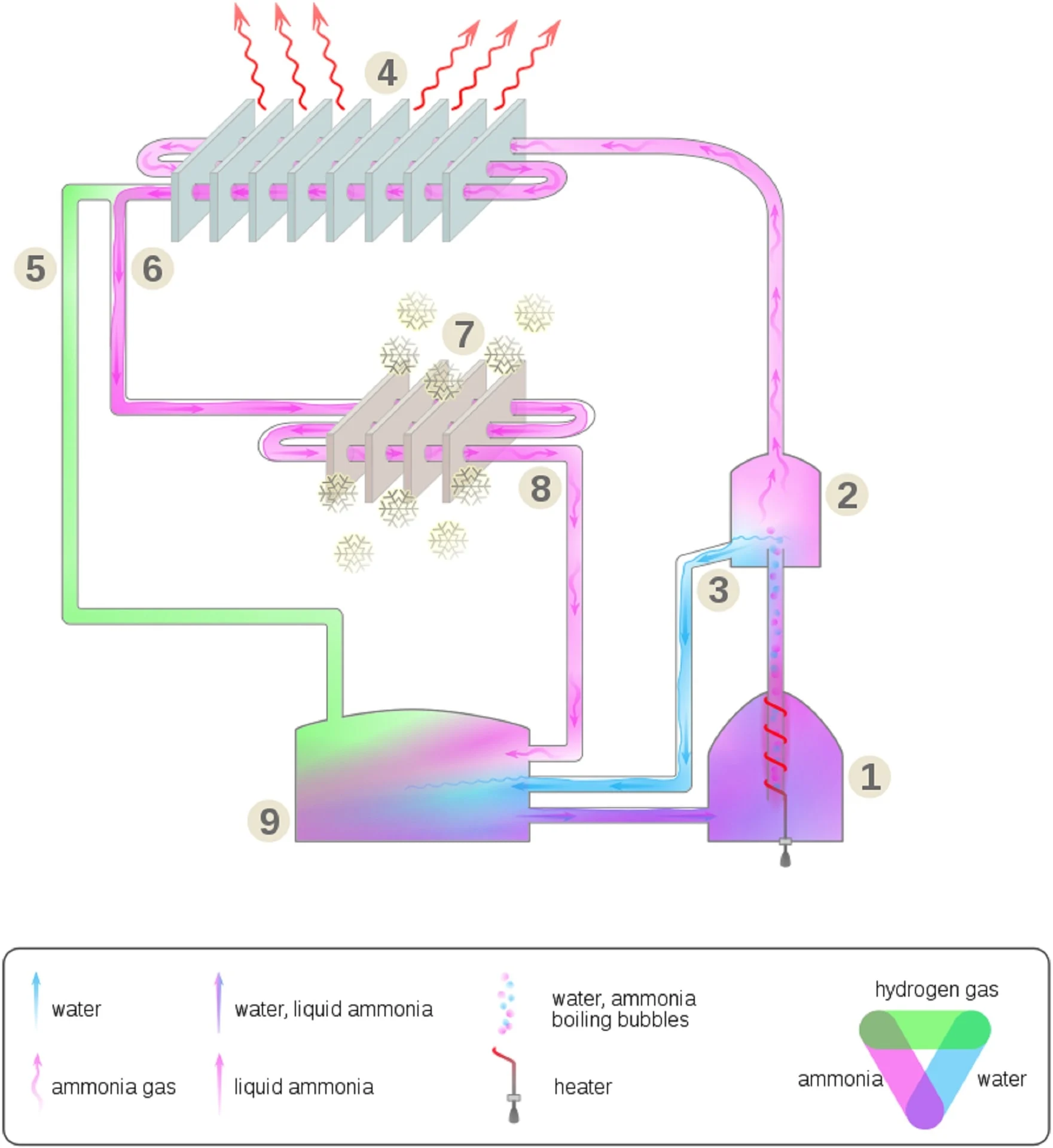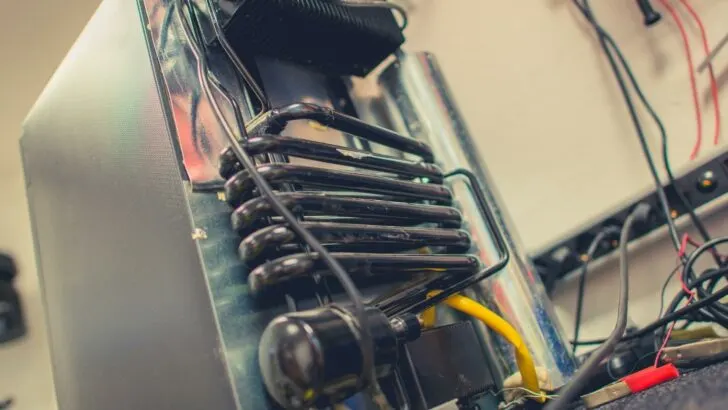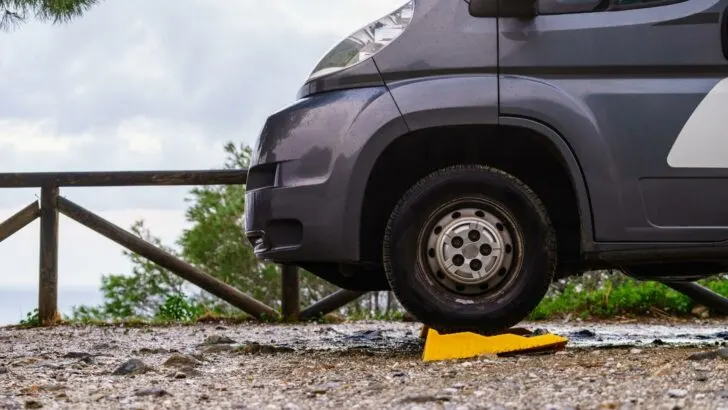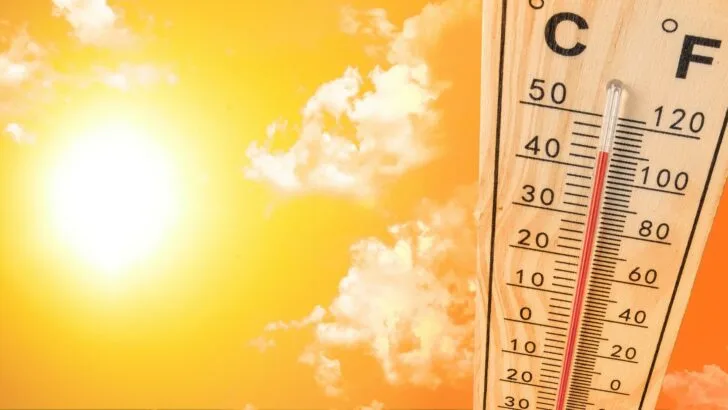An absorption refrigerator, like those frequently found in an RV (and commonly referred to as an “RV refrigerator”), uses heat to cool your food and beverages. How can that be?
Today we’re taking a closer look at the RV absorption refrigerator – what it is, how it works, how it’s powered, how efficient it is, and what to do if yours isn’t cooling well.
That’s a lot to cover in a single post, so let’s not waste any time!
- 1) What is an Absorption Refrigerator?
- 2) How Does an Absorption Fridge Work?
- 3) Does an Absorption Fridge Use a Lot of Electricity?
- 4) How Cold Does an Absorption Fridge Get?
- 5) Does an RV Fridge Work Better on Gas or Electric?
- 6) Are Absorption Fridges Any Good?
- 7) Absorption Refrigerator vs Compressor Efficiency
- 8) Absorption Fridge Not Cooling?
- 9) Read More About RV Refrigerators
What is an Absorption Refrigerator?
An absorption refrigerator uses a gas flow heat exchange system to extract heat from the fridge and cool the interior fridge and freezer compartments.
A 3-way RV absorption refrigerator can generally be powered in three ways: propane (LP) gas, 12V battery power (most often only when the RV’s engine and alternator are supplying power), or 120V AC power (when plugged into shore power or running off a generator).
There are also 2-way absorption refrigerators. Most commonly, these can run on propane or 120V AC (shore) power (though there’s also another type of 2-way fridge that’s actually a compressor fridge that can run on either 120V AC power or 12V DC power when off-grid).
But most RV absorption fridges are 3-way fridges that run on propane (great for use when boondocking off the grid), 12V battery power (good only for short durations), or 120V AC power (when plugged into any source of 120V power such as shore power at a campground or RV park).
Let’s take a look at how an RV absorption refrigerator works.
How Does an Absorption Fridge Work?

This absorption refrigerator diagram shows the cooling cycle of an absorption fridge. (Photo credit: Wikipedia)
An absorption fridge uses either a propane burner flame or an electric heating element to work.
The three stages of functioning involve evaporation, absorption, and regeneration. The process uses an ammonia-based liquid refrigerant, with water as the absorbent and to lower the evaporation point of the ammonia to a point that’s below the temperature of the interior of the fridge.
If you look at the back of your RV absorption fridge, you’ll see tubes, coils, and fins.
Here’s how it all works:
- Heat is supplied to a liquid refrigerant (typically ammonia & water), causing the mixture to boil and turn into a gas.
- The now gaseous refrigerant travels through a separation chamber where the water vapor condenses back to a liquid.
- The liquid water returns to the absorption chamber.
- The hot gaseous ammonia continues to rise through a condenser coil located near the top of the refrigerator where the heat is extracted (to the outside air), causing the ammonia to condense back to a cold liquid form.
- Hydrogen gas (released during the condensing cycle) is separated and returned to the absorption chamber.
- The cooled, liquid ammonia now flows (due to gravity) down to an evaporator coil, drawing heat from the freezer and then refrigerator compartments.
- The heat absorbed from the interior of the refrigerator heats the liquid ammonia again, causing it to return to gas form.
- The ammonia gas continues to flow toward the absorption chamber.
- In the absorption chamber, the ammonia gas mixes with the water that was returned to the absorption chamber in step #3 and is now ready to repeat the cooling cycle.
This is a completely closed system in which the refrigerant is constantly recycled, making it a very efficient system.

This photo of the back of an absorption refrigerator shows the coils, fins, and electrical wires involved.
Does an Absorption Fridge Use a Lot of Electricity?
Absorption refrigerator efficiency and how much electricity it uses varies depending on what mode it’s operating in. An absorption fridge is most efficient when operating in propane mode, however.
When operating in propane mode, an absorption fridge uses very little electricity. Propane mode is, in fact, the mode that uses the least electricity by far. It will vary to some degree, but the only electricity (12V DC) an RV absorption refrigerator uses when running in LP (liquid propane) mode is just enough to run any connected fans, general (very small) parasitic loads, a lightbulb, and a thermostat (unless you have a “door heater” climate system or an ice maker, both of which will add more power usage).
In 120V mode, the same 12V DC power listed above is being used, but the absorption fridge uses its 120V AC heating element in place of the propane. The heat generated by the AC heater is what initiates the cooling cycle, boiling the water/ammonia mixture. An RV refrigerator can run off of 120V AC when connected to shore power or when running a generator (onboard or portable).
How Cold Does an Absorption Fridge Get?
The cooling ability of an absorption refrigerator operating in LP (liquid propane) mode is impacted significantly by the ambient temperature. So if the weather is very hot, your fridge will have more difficulty cooling. In fact, extreme heat AND extreme cold both affect the functioning of an absorption refrigerator (as does high altitude).
So, we have to look at how cold an absorption fridge can get in relation to the ambient temperature. In general, in excellent conditions, an absorption refrigerator will cool the fridge compartment to somewhere around 40 degrees (Fahrenheit) below ambient (outside) temperature.
This is a very important piece of information to understand about absorption fridges, because if you’re camping where the ambient temperature is 75℉, the fridge compartment of an RV absorption fridge may cool to around 35℉ or more, depending on where you set the thermostat.
However, if your ambient temperature is 90℉, your fridge temp may climb to around 50℉, and that may be too high for the safety of certain foods.
This is why people install after-market fans into the rear of the RV refrigerator – to better circulate air across the condenser to improve the cooling ability of the fridge. Other tips involve parking in the shade, cooling your food before you put it into the fridge, and opening the fridge as infrequently as possible in hot weather conditions.
Fans like the ones below, or small computer fans installed at the back of the fridge, can have a very significant beneficial effect on cooling. Fans inside the fridge compartment also help to equalize the temperature throughout the refrigerator by circulating the air and preventing warm spots:
- HIGH POWER 3,000 R/M MOTOR AND DURABLE CONSTRUCTION - PATENT PENDING -While competitor versions use around 700 R/M motors, the Beech Lane fan uses a...
- LIFETIME WARRANTY AND USA BASED CUSTOMER SERVICE - If the fan ever stops working properly or is damaged, it is covered by a lifetime manufacturer...
- RV'ers number 1 choice
- one year warranty
- DESIGN FOR VENT & GRILLE MOUNTING VENTILATION- Great for refrigerator vent & grille ventilation in your motorhome, camper van, camper truck, caravan...
- FLEXIBLE AND SMART SPEED CONTROL MODE- Auto Temperature Control/ 6-levels manual controller to adjust for particular needs
Does an RV Fridge Work Better on Gas or Electric?
Once the cooling process is started, an RV fridge should run about the same regardless of the source of heat. However, there is a difference in the amount of heat each source can supply to kick things off.
Propane is by far the most efficient way to run an absorption refrigerator. Once the propane is ignited, it supplies the largest amount of heat to the burner chamber, getting the cooling process started quickly. Running on 120V AC power is the next best choice, with the 12V DC heating element being the least powerful way to run an RV absorption fridge (and primarily designed to maintain an already-cool fridge while you’re underway/driving).
Are Absorption Fridges Any Good?
In many ways, they’re fantastic. But, of course, there are two sides to every coin. So, to more thoroughly answer this question, let’s take a look at the pros and cons of absorption fridges:
Advantages of RV Absorption Refrigerators
- Highly efficient in LP mode and can run for long durations of time as they rely on the gas flow exchange system (and require only minimal amounts of 12V DC power from your RV’s battery(ies) to operate circuitry, etc)
- Can be used when boondocking, requiring no connection to shore power, a large solar system, or a generator
- The heat exchange system is silent for quiet operation
Disadvantages of RV Absorption Refrigerators
- The fridge needs to be level for efficient operation and for the health of the appliance (it varies by RV fridge manufacturer but is generally within just a few degrees front-to-back and side-to-side)
- Require good ventilation while using propane gas mode and to ensure efficient operation
- Inefficient on 12V and drains batteries quickly
- The cooling ability of an absorption fridge is impacted by ambient temperatures

One of the disadvantages of an RV absorption refrigerator is the need for the RV (and thus the fridge) to be level for proper cooling.
Absorption Refrigerator vs Compressor Efficiency
Let’s take a look at the pros and cons of an RV compressor fridge to see how it compares with an absorption fridge for RVs:
Advantages of Compressor Refrigerators
- Capable of cooling to lower temperatures regardless of ambient temp
- Cool more consistently due to the compressor motor
- Can serve as a freezer due to its powerful compressor motor
- Will operate regardless of whether the RV is level or on an incline/decline
- Run more efficiently on 12V battery power (mostly applicable to 12V compressor refrigerators, as 120V AC refrigerators require an inverter which adds inefficiency)
Disadvantages of Compressor Refrigerators
- May be noisy while the compressor is running
- May require power assistance such as solar to charge the batteries that power the refrigerator
Absorption Fridge Not Cooling?
If your absorption fridge isn’t cooling as well as it should be, there are several common issues that may be responsible.
Let’s take a look at what might be happening, along with some absorption refrigerator repair ideas.
Fridge Works, But Isn’t Cooling Well in Hot Weather

RV absorption refrigerators struggle to cool well when the ambient temperature is high.
If your RV refrigerator is running but isn’t cooling well in hot weather, there are a few things you can do to try to address this issue.
First, it’s important for your absorption fridge to be able to reject its own heat. This is why (external) fans are often added – they add to the effectiveness of ventilation, enabling the fridge to cool more efficiently. It’s also possible that either your burner tube or the fridge’s flue/vent (or both) need cleaning. Insect nests or other debris may be affecting the fridge’s efficient operation.
Whenever you travel in hot weather, be sure to try to park your RV so that the fridge side is in the shade. The sun will always increase the heat and impact your fridge’s performance.
Consider the age of your RV absorption fridge. In general, the cooling units of absorption fridges last around 15-20 years or so. Thereafter, it’s possible that the cooling unit is bad.
And finally, if there’s a problem with the insulation of the fridge, it may start having difficulty staying cool. If your fridge’s insulation fails after many years, you may see bulging on the sides of the fridge. This occurs if the vacuum panels inside the walls of the fridge rupture or get punctured.
Fridge Isn’t Cooling Well Regardless of the Ambient Temperature
If your RV absorption fridge isn’t cooling well no matter what the ambient temperature is, the burner may need cleaning. If you remove the shield from the back of your fridge and notice that the flame isn’t burning well or at all, you’ll need to remove the burner and give it a good cleaning. Sometimes a burner will need to be replaced, but it can frequently be cleaned with good results.
If your fridge isn’t clicking on when it should, there could be an issue with the thermostat and it may need to be replaced.
If you notice that the burner is running constantly but the fridge isn’t getting cold, check the burner flame. What you should see is a strong continuous blue flame. If you see a weak, flickering, or orange flame, that’s another sign that your burner needs to be cleaned (or, you may be at too high an elevation, which will reduce the efficiency of the burner… and, thus the efficiency of the fridge’s ability to function… consider moving to a lower elevation as soon as possible).
And finally, the seals around the door of the fridge are prone to fail over time and use. An easy way to check the seal is to close the door on a dollar bill or a piece of paper. If you don’t feel resistance and the paper is easily pulled out of the closed door, then your door seals are failing. Be sure to check in various places all the way around the entire perimeter of each door (there can be up to four) to check for leaks.
Read More About RV Refrigerators
For more information, see our post all about the RV refrigerator, as well as our thoughts on the best refrigerator for an RV. If you’re interested in the reasons why we ultimately moved to an RV residential refrigerator, you can check out that post as well.
Geek Out with Us Every Week
Join our newsletter to learn about all things RV-related. Every week we offer free tips, tricks, product reviews, and more to our online community of RVers. So, whether this is your first time on the road or you’re a seasoned expert, we’d love for you to geek out with us!





MLB
Tuesday 5th of July 2022
I have the 2 way version with 2 freezer compartments and one fridge compartment. My problem is that the freezer isn't cold enough and the fridge is too cold, Gas or 120 doesn't make a difference. Even on 9, the highest setting, the left freezer compartment will be in the low single digits (soft ice cream); the right freezer compartment will be around 10 - 12 and the fridge will be in the upper 20's - 32. The gaskets checked ok, looks good in the back, the external fans work. This is parked in the shade in 70 - 80 weather. Only 2 weeks with this (bought used) coach. Previous had a residential fridge so my 1st time with absorption
MLB
Friday 8th of July 2022
@TheRVgeeks, thank you for the information. It wouldn't be the first 2 because it gets shut down (with the doors cracked) each time we are home, for a week or more. I've removed the thermistor & tested it with a VOM and it tested ok but I haven't investigated the position. Even if it's located properly, it's something I can experiment with. I should probably just be patient & keep working with it. We've only had it for a month and used it for 2 one week trips. Thanks again!
TheRVgeeks
Tuesday 5th of July 2022
Oh boy, MLB. Sorry to hear about that. Couple of thoughts:
Check to be sure that the freezer doesn't need defrosting. If you're in a humid area, and lots of frost has built up at the back of the freezer, it prevents the freezer compartment from getting cold enough. Remove all the food, shut the fridge down, and let it defrost completely before firing it back up. It's possible that the fridge was run off-level enough that the coolant (the ammonia solution) isn't able to all return to the bottom "reservoir", so you're not getting a complete cooling cycle. Again, shutting the fridge down for at least a few hours (and being sure it's as close to level as possible) will allow it to "reset". The thermistor that's attached to the fins at the back of the refrigerator portion may need to be moved (or accidentally WAS moved and is now in the wrong place). If you Google for that, you may find directions on where to look for it, and where it should be. But, basically, that thermistor is supposed to monitor the temperature of the fins at the back of the fridge and may be causing things to cycle at the incorrect time.If none of the above helps, you may need to have a Norcold service tech look it over and see if anything else is wrong.
TJL
Tuesday 5th of July 2022
It is worth noting that internal fans cool nothing. They simply circulate air (as you indicated) to even out temps within the fridge. The same thing happens naturally since the cooling fins are located at the top where the warmest air is cooled and falls due to higher density. Regarding leveling, my manual indicates if the rig is level enough for comfortable sleeping, it is OK for the fridge; no specs provided. Nevertheless, I occasionally check with an electronic level: 3 deg front to back, 6 deg side to side (rig not fridge). A 3-way fridge (which I have) is a marginal performer, although I have never had food spoil and have bought ice only once when the outside temp was 100+. I have had very soupy ice cream.
A few additional tips: 1. Face fridge side to the north, if you can. This avoids the sun. Second choice is east. This avoids the mid-day and afternoon sun. 2. Use the awning to shade the fridge. Even better park in the shade. This obviously compromises any solar panels; which I don't have because I seek shade in warm weather. 3. If necessary, move ice packs from freezer to fridge during the warmer day and back to the freezer during the cooler night. 4. Ice/frost on the cooling fins compromise heat transfer. However, ice/frost on the fins of the freezer may actually sacrifice performance of the freezer and help the fridge since more cooling occurs at the fridge fins. 5. If you have a temperature monitoring system, remember that the food temps change slower than the air temps, both when cooling and warming. 6. ALWAYS start the fridge the night before travelling and pre-cool all the food.